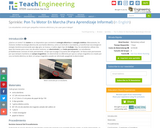
Los estudiantes construyen pequeños motores eléctricos y los usan para trabajar!
- Subject:
- Applied Science
- Engineering
- Material Type:
- Activity/Lab
- Provider:
- TeachEngineering
- Provider Set:
- Sprinkles
- Date Added:
- 01/01/2015

TeachEngineering is a standards-aligned, classroom tested digital collection. University engineering faculty, graduate students and K-12 teachers across the nation developed and classroom tested the contents of the TeachEngineering collection, which showcases engineering in everyday life as the context for student learning. Specific contributions by individual authors are recognized at the end of every lesson and activity. The collection aligns with state and/or national science, mathematics and technology educational standards, and uses engineering as the vehicle to integrate science and mathematics concepts for K-12 students.
The University of Colorado Boulder and Oregon State University continue to apply rigorous standards to the publishing process and enhance user features, while creating systems infrastructure to optimize for the growing content, and user base, of the library. TeachEngineering continues to expand with published curricula from almost 70 different institutions. Most curricular contributions are authored by the professors, graduate students and teachers associated with NSF-funded engineering colleges from across the country, primarily GK-12 and RET grantees.

Los estudiantes construyen pequeños motores eléctricos y los usan para trabajar!
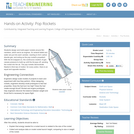
Students design and build paper rockets around film canisters, which serve as engines. An antacid tablet and water are put into each canister, reacting to form carbon dioxide gas, and acting as the pop rocket's propellant. With the lid snapped on, the continuous creation of gas causes pressure to build up until the lid pops off, sending the rocket into the air. The pop rockets demonstrate Newton's third law of motion: for every action, there is an equal and opposite reaction.
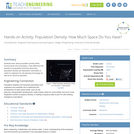
Students learn about population density within environments and ecosystems. They determine the density of a population and think about why population density and distribution information is useful to engineers for city planning and design as well as for resource allocation.
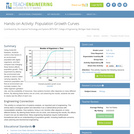
Using Avida-ED freeware, students control a few factors in an environment populated with digital organisms, and then compare how changing these factors affects population growth. They experiment by altering the environment size (similar to what is called carrying capacity, the maximum population size that an environment can normally sustain), the initial organism gestation rate, and the availability of resources. How systems function often depends on many different factors. By altering these factors one at a time, and observing the results, students are able to clearly see the effect of each one.
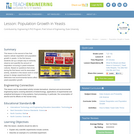
This lesson is the second of two that explore cellular respiration and population growth in yeasts. In the first lesson, students set up a simple way to indirectly observe and quantify the amount of respiration occurring in yeast-molasses cultures. Based on questions that arose during the first lesson and its associated activity, in this lesson students work in small groups to design experiments that will determine how environmental factors affect yeast population growth.
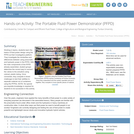
Working in teams, students learn the basics of fluid power design using the PFPD as their investigative platform. They investigate the similarities and differences between using pneumatic and hydraulic power in the PFPD. With the main components of the PFPD already assembled, student groups determine the correct way to connect the valves to the actuators using colored, plastic tubing. Once connected, they compete in timed challenges to test their abilities to separate material out of containers using the PFPDs. NOTE: No special pre-requisite knowledge is required for students to be successful in this activity.
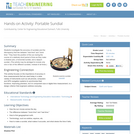
Students investigate the accuracy of sundials and the discrepancy that lies between "real time" and "clock time." They track the position of the sun during the course of a relatively short period of time as they make a shadow plot, a horizontal sundial, and a diptych sundial. (The activity may be abridged to include only one or two of the different sundials, instead of all three.)
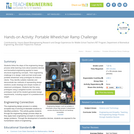
Students follow the steps of the engineering design process while learning more about assistive devices and biomedical engineering applied to basic structural engineering concepts. Their engineering challenge is to design, build and test small-scale portable wheelchair ramp prototypes for fictional clients. They identify suitable materials and demonstrate two methods of representing design solutions (scale drawings and simple models or classroom prototypes). Students test the ramp prototypes using a weighted bucket; successful prototypes meet all the student-generated design requirements, including support of a predetermined weight.
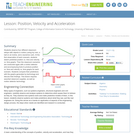
Students observe four different classroom setups with objects in motion (using toy cars, a ball on an incline, and a dynamics cart). At the first observation of each scenario, students sketch predicted position vs. time and velocity vs. time graphs. Then the classroom scenarios are conducted again with a motion detector and accompanying tools to produce position vs. time and velocity vs. time graphs for each scenario. Students compare their predictions with the graphs generated by technology and discuss their findings. This lesson requires assorted classroom supplies, as well as motion detector technology.
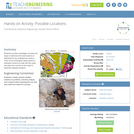
Students use their knowledge of scales and areas to determine the best locations in Alabraska for the underground caverns. They cut out rectangular paper pieces to represent caverns to scale with the maps and place the cut-outs on the maps to determine feasible locations.
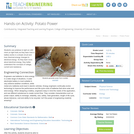
Students use potatoes to light an LED clock (or light bulb) as they learn how a battery works in a simple circuit and how chemical energy changes to electrical energy. As they learn more about electrical energy, they better understand the concepts of voltage, current and resistance.
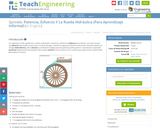
Los ingenieros civiles, geotécnicos, medio ambientales, mecánicos y eléctricos colaboran para diseñar y construir presas que generan electricidad a partir de la corriente del agua. Cuando los ingenieros diseñan estas presas, llamadas plantas de energía hidroeléctrica, ellos calculan la cantidad de energía que estas plantas pueden generar. Conociendo la capacidadpotencial de generación que poseen, ellos pueden estimar el área máxima rural o urbana que puede recibir la electricidad generada por la presa.
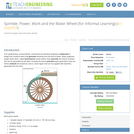
Students design and build water wheels.
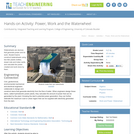
Waterwheels are devices that generate power and do work. Student teams construct waterwheels using two-liter plastic bottles, dowel rods and index cards, and calculate the power created and work done by them.
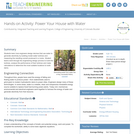
Students learn how engineers design devices that use water to generate electricity by building model water turbines and measuring the resulting current produced in a motor. Student teams work through the engineering design process to build the turbines, analyze the performance of their turbines and make calculations to determine the most suitable locations to build dams.
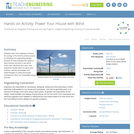
Students learn how engineers harness the energy of the wind to produce power by following the engineering design process as they prototype two types of wind turbines and test to see which works best. Students also learn how engineers decide where to place wind turbines, and the advantages and disadvantages to using wind power compared to other non-renewable energy sources.
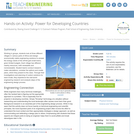
Working in groups, students look at three different villages in various parts of Africa and design economically viable engineering solutions to answer the energy needs of the off-the-grid small towns, given limited budgets. Each village has different nearby resources, both renewable and nonrenewable. Student teams conduct research, make calculations, consider the options and create plans, which they present to the class. Through their investigations and planning of custom solutions for each locale, they experience the real-world engineering research and analysis steps of the engineering design process.
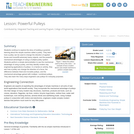
Students continue to explore the story of building a pyramid, learning about the simple machine called a pulley. They learn how a pulley can be used to change the direction of applied forces and move/lift extremely heavy objects, and the powerful mechanical advantages of using a multiple-pulley system. Students perform a simple demonstration to see the mechanical advantage of using a pulley, and they identify modern day engineering applications of pulleys. In a hands-on activity, they see how a pulley can change the direction of a force, the difference between fixed and movable pulleys, and the mechanical advantage gained with multiple / combined pulleys. They also learn the many ways engineers use pulleys for everyday purposes.
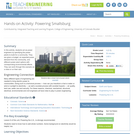
In this activity, students act as power engineers by specifying the power plants to build for a community. They are given a budget, an expected power demand from the community, and different power plant options with corresponding environmental effects. They can work through this scenario as a class or on their own.
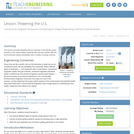
This lesson provides students with an overview of the electric power industry in the United States. Students also become familiar with the environmental impacts associated with a variety of energy sources.